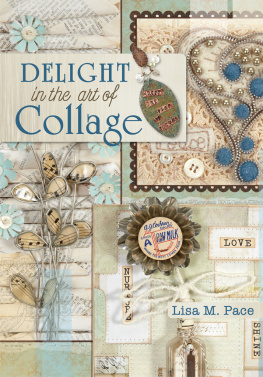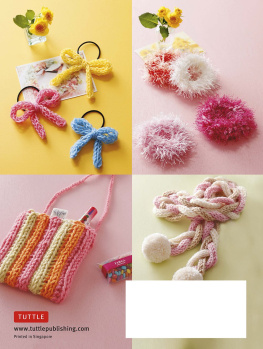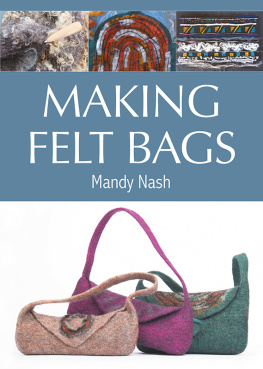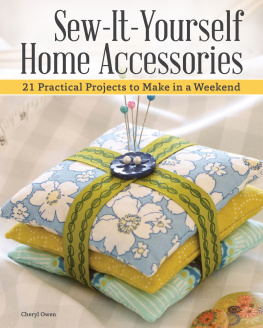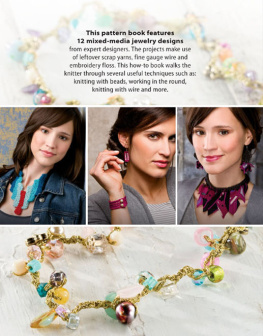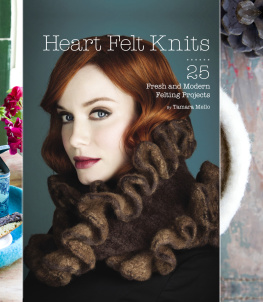Felt Forward
MODERN DESIGNS IN KNITTED FELT
Maggie Pace

forSTEVE
Acknowledgments
Id like to thank my family for supporting me while working on this project: my mom, Joan Benson, who was the first to (patiently) knit most everything; my husband, Steve Pace, who was the first to see the sketches; and my kids for putting up with yarn all over the house, tangling up their little feet. Id like to thank my in-laws for their continuous support, especially my mother-in-law, Elaine Pace, who was with me when the concept of Felt Forward was developed on a long family road trip. She gave me great feedback on that first round of ideas. Id like to thank my business partner at Pick Up Sticks, Kelly Wilkinson, for her design insight and also her support with the business as I was working on the book.
Id like to thank the creative, insightful, and diligent editorial team at Interweave Press, especially my editor, Anne Merrow. She is an absolute delight to work with, and she did a superb job of seeing the vision for Felt Forward and executing it. Her attention to detail and her calm demeanor were both critical to me in the completion of this book. Thanks to technical editor Traci Bunkers and proofreader Nancy Arndt, who helped to tighten up the manuscript. I am deeply grateful for everyone who worked on the design of the book itself; photographer Joe Coca, stylists Ann Swanson and Annie Bakken, graphic designer Karla Baker, and illustrator Ann Swanson were able to work together to bring the project, as a whole, into clear focus. Thanks to Betsy Armstrong for inviting me to work with Interweave and for believing in my designs from the very beginning. Id also like to express my appreciation to those involved on the business side, especially Marilyn Murphy, who has been wonderfully supportive of the project.
I am very grateful to the knitters who worked quickly under tight deadlines, especially my mom (again!), Trish Egan, Mayumi Hughes, and Jan Hanson. Id like to thank all the yarn companies who provided materials for the samples in this book (these are listed in the resource guide).
Thanks, finally, to everyone who has supported me and Pick Up Sticks by purchasing my designs. Its the feedback at shows and e-mail messages from people knitting my patterns that keep the creative juices flowing!
maggie pace

Contents

Felt Forward is a collection of patterns for felters wholike meare smitten with the craft and are ready to explore more of what is possible from it. As you thumb through these pages, youll notice that each project offers an original perspective: The design may be uniquely constructed. It may have an unusual use. It may be made of a yarn not generally deemed feltable. The patterns arent more difficult or more time-consuming than other felted knits. They dont require an extensive background in felting or even years of experience in knitting. What they do require is a sense of adventure and a desire to make a handknit that is just a bit out of the ordinary.
I began felting after I saw a purse a next door neighbor brought home from France. I had never seen anything like it. When she told me it was handknitted and boiled, I could not believe I would be able to make something like that with knitting.
That night, I went home and looked up boiled wool on the Internet. Armed with the knowledge that all the process took was hot water, agitation, and animal hair, I found an old wool hat, boiled a pot of water, and plopped it in. After beating it consistently for about 25 minutes, the hat was transformed, and I was transfixed. I was so excited that I went into manic knitting overdrive. I knitted a small bag with a long strap and felted it (this time in the washing machine!) right away. I was so proud of it I wore it wet to the grocery store.
During the next four years, I worked with just about every type of animal fiber, using almost every known knitting technique (and some not-so-well known). In the beginning I learned the basics: Felted knits shrink way more in length than they do in width. I-cords tangle if you dont babysit them. One-hundred percent wool felts matte; wool/mohair blends felt really fuzzy.
The deeper I got into felting, the more I experimented. One day I found I could make space-age looking bubbles in fabric using water balloons. Later I discovered I could knit onto a shower curtain ring and felt it, transforming an ugly household widget into the building block of a hip design. Ive wasted a lot of good knitting trying newfangled ideas. But Ive also pulled some winners out of the washer, although I was sure as I put them in they would flop.
The pages of Felt Forward are filled with the results of these experiments. I chose these designs because each has something innovative to offer.
BACK TO BASICS
Even though the techniques in this book push the envelope of what is possible with knitted felt, the way the items are knitted and felted will be very familiar. To guide you through the basic mechanics of knitting, there is a glossary at the back of this book where you will find common abbreviations and explanations of techniques.
There is also a section devoted to felting, where youll learn about felting in the washing machine and by hand, knowing when a piece is ready to be pulled out, and troubleshooting if something goes wrong.
Now all thats left to do is pick a project and get knitting. Felt on!
Wool felt is the earliest known type of textile fabric, predating weaving or spinning. It likely originated in Central Asia 8,000 years ago, and historically its uses have been relegated to creating comfort and shelter: Ancient Scandinavians used the fabric to make hats and mittens. Russians used it to make soft boots. In Central Asia, nomadic tribes still employ the lightweight, weatherproof fabric for tents.
But what happens when this most ancient of textiles is used in more modern ways? By cajoling the traditionally cozy textile into different shapesones better described as sleek or chicthe patterns in this section lure felt away from its comfy roots and ask more of it.
Bold repeating shapes. Structural designs. Graphic motifs. These are a few of the hallmarks of modern design. When applied to knitted felt, a whole new genre emerges: modern felt.
CIRCLES
No other form explores the modern sensibility more enticingly than the circle. Solo, a circle earns its design punch through its simplicity. But when conjoined, circles appeal lies in their complexity. Look at a linked o motif long enough, and soon two designs emerge: the dominant circles and the curved diamond shapes of the negative space in between. Both the Circles Table Runner & Placemat () explore this concept of negative space, something more commonly attempted in crochet than knitted felts. Designed as a set, they each have a mid-century modern appeal that will make them at home in the most minimalist of dwellings.
Structure is the name of the game with the City Girl Duffel () and a set of circles provides the backbone. Certainly the two circular ends in a contrasting color lend design flair, but their true purpose is to hold the bags bold cylindrical shape. Modern form sets the duffel apart from its slouchy-felted-bag brethren and plants it firmly in the urban gym.
Next page

